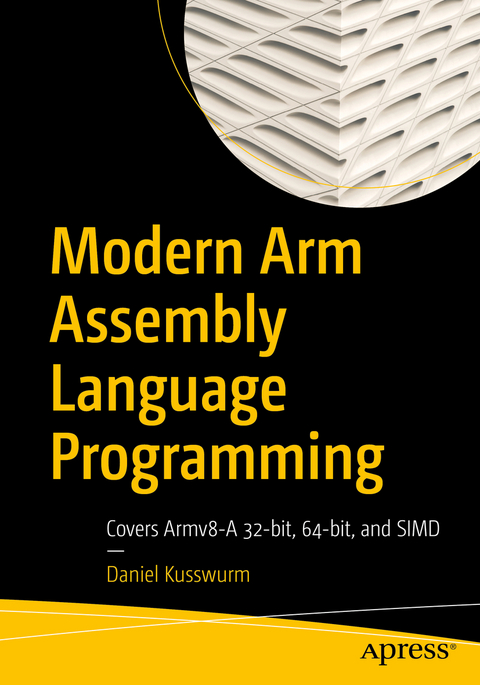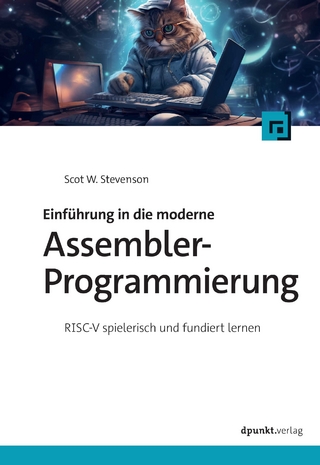
Modern Arm Assembly Language Programming
Apress (Verlag)
978-1-4842-6266-5 (ISBN)
Modern Arm Assembly Language Programming accentuates the coding of Armv8-A 32-bit and 64-bit assembly language functions that are callable from C++. Multiple chapters are also devoted to Armv8-A SIMD assembly language programming. These chapters discuss how to code functions that are used in computationally intense applications such as machine learning, image processing, audio and video encoding, and computer graphics.
The source code examples were developed using the GNU toolchain (g++, gas, and make) and tested on a Raspberry Pi 4 Model B running Raspbian (32-bit) and Ubuntu Server (64-bit). It is important to note that this is a book about Armv8-A assembly language programming and not the Raspberry Pi.
What You Will Learn
See essential details about the Armv8-A 32-bit and 64-bit architectures including data types, general purpose registers, floating-point and SIMD registers, and addressing modes
Use the Armv8-A 32-bit and 64-bit instruction sets to create performance-enhancing functions that are callable from C++
Employ Armv8-A assembly language to efficiently manipulate common data types and programming constructs including integers, arrays, matrices, and user-defined structures
Create assembly language functions that perform scalar floating-point arithmetic using the Armv8-A 32-bit and 64-bit instruction sets
Harness the Armv8-A SIMD instruction sets to significantly accelerate the performance of computationally intense algorithms in applications such as machine learning, image processing, computer graphics, mathematics, and statistics.
Apply leading-edge coding strategies and techniques to optimally exploit the Armv8-A 32-bit and 64-bit instruction sets for maximum possible performance
Who This Book Is For
Software developers who are creating programs for Armv8-A platforms and want to learn how to code performance-enhancing algorithms and functions using the Armv8-A 32-bit and 64-bit instruction sets. Readers should have previous high-level language programming experience and a basic understanding of C++.
Daniel Kusswurm has over 35 years of professional experience as a software developer and computer scientist. During his career, he has developed innovative software for medical devices, scientific instruments, and image processing applications. On many of these projects, he successfully employed assembly language to significantly improve the performance of computationally intense algorithms or solve unique programming challenges. His educational background includes a BS in electrical engineering technology from Northern Illinois University along with an MS and PhD in computer science from DePaul University. Daniel Kusswurm is also the author of Modern X86 Assembly Language Programming (ISBN-13: 978-1484200650) and Modern X86 Assembly Language Programming, Second Edition (ISBN-13: 978-1484240625), both published by Apress.
Chapter 1 – Armv8-32 Architecture.- Chapter 2 – Armv8-32 Core Programming – Part 1.- Chapter 3 – Armv8-32 Core Programming – Part 2.- Chapter 4 – Armv8-32 Core Programming – Part 3.- Chapter 5 – Armv8-32 Floating-Point Architecture.- Chapter 6 – Armv8-32 Floating-Point Programming.- Chapter 7 – Armv8-32 SIMD Architecture.- Chapter 8 – Armv8-32 SIMD Integer Programming.- Chapter 9 – Armv8-32 SIMD Floating-Point Programming.- Chapter 10 – Armv8-64 Architecture.- Chapter 11 – Armv8-64 Core Programming – Part 1.- Chapter 12 – Armv8-64 Core Programming – Part2.- Chapter 13 – Armv8-64 Floating-Point Programming.- Chapter 14 – Armv8-64 SIMD Integer Programming.- Chapter 15 – Armv8-64 SIMD Floating-Point Programming.- Chapter 16 – Armv8-64 Advanced SIMD Programming.- Chapter 17 –Optimization Strategies and Techniques.- Appendix A – Source Code and Software Development Tools.- Appendix B – References and Additional Resources.
| Erscheinungsdatum | 16.10.2020 |
|---|---|
| Zusatzinfo | 67 Illustrations, black and white; XIX, 465 p. 67 illus. |
| Verlagsort | Berkley |
| Sprache | englisch |
| Maße | 178 x 254 mm |
| Themenwelt | Informatik ► Programmiersprachen / -werkzeuge ► Assembler |
| Informatik ► Software Entwicklung ► Mobile- / App-Entwicklung | |
| Informatik ► Weitere Themen ► Hardware | |
| Schlagworte | 32-bit • 64-Bit • Arm • Armv8-A • Assembly • Hardware • Mobile • Modern • programming • SIMD • smartphones • Tablets |
| ISBN-10 | 1-4842-6266-2 / 1484262662 |
| ISBN-13 | 978-1-4842-6266-5 / 9781484262665 |
| Zustand | Neuware |
| Haben Sie eine Frage zum Produkt? |
aus dem Bereich


